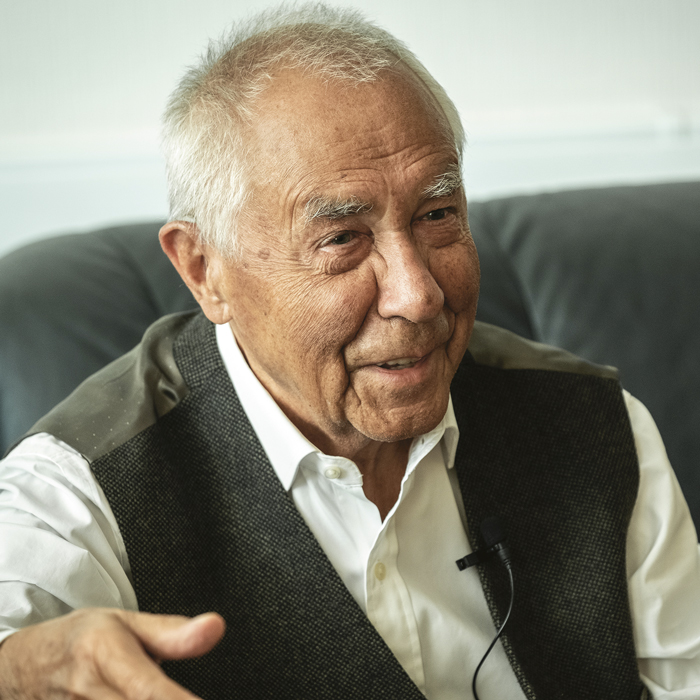 Nicolay Basov (1922-2001) entered the MEPhI in 1946 and defended his diploma in 1950. He worked at the university from 1960 to 2001. In 1978 he organized and headed the Department of quantum electronics, later renamed to the Department of laser physics.
Nicolay Basov (1922-2001) entered the MEPhI in 1946 and defended his diploma in 1950. He worked at the university from 1960 to 2001. In 1978 he organized and headed the Department of quantum electronics, later renamed to the Department of laser physics.
Basov discovered the stimulated emission. It means that a light packet, a photon, coming in contact with an atom can cause an electron to descend to a lower energy level so that an additional photon with the same amount of energy is emitted. If electrons are elevated to higher energy levels with the help of heat or light, an avalanche-like effect occurs when they fall to lower levels.
In the 1950s Nicolay Basov, Aleksandr Prokhorov and Charles Townes contributed to putting this phenomenon into practical use in masers and lasers, which produce concentrated and coherent beams of microwaves and light, respectively.
While working at MEPhI, in 1964, Basov, together with Prokhorov and Townes, received the Nobel Prize in Physics "for fundamental work in the field of quantum electronics, which has led to the construction of oscillators and amplifiers based on the maser-laser principle".
 Victor Kirillov-Ugryumov (1924-2007) graduated from MEPhI in 1949. In 1953 he defended his PhD thesis and at the age of 29 became the dean of the faculty of experimental and theoretical physics at MEPhI, and in 1961 he became rector of the university. After that, MEPhI became one of the leading universities in the country.
Victor Kirillov-Ugryumov (1924-2007) graduated from MEPhI in 1949. In 1953 he defended his PhD thesis and at the age of 29 became the dean of the faculty of experimental and theoretical physics at MEPhI, and in 1961 he became rector of the university. After that, MEPhI became one of the leading universities in the country.
Professor Kirillov-Ugryumov in 1970-1974 was the chairman of the Council of Rectors of Moscow universities, in 1974-1987 he headed the Higher Attestation Commission under the USSR Council of Ministers and introduced enhanced requirements for applicants for academic degrees and professions.
 Yuri Oganessian (b. 1933) graduated from MEPhI in 1956. In 1970 he received a doctorate in physical and mathematical sciences, in 2003 he was elected the full member of the Russian Academy of Science. Now works as director of Flerov Laboratory of Nuclear Reactions, Joint Institute for Nuclear Research, Dubna.
Yuri Oganessian (b. 1933) graduated from MEPhI in 1956. In 1970 he received a doctorate in physical and mathematical sciences, in 2003 he was elected the full member of the Russian Academy of Science. Now works as director of Flerov Laboratory of Nuclear Reactions, Joint Institute for Nuclear Research, Dubna.
Professor Oganessian is considered the world's leading researcher in superheavy chemical elements. He led the discovery of these elements (104 element - Rutherfordium, 105 element - Dubnium, 106 element - Seaborgium, 107 element - Boron) in the periodic table. The heaviest element on the periodic table, Oganesson, is named after him, only the second time that an element was named after a living scientist (the other being Seaborgium).
 Nikolai Ponomarev-Stepnoy (b. 1928) graduated from MEPhI in 1952. At the Institute of Atomic Energy, he went from a young specialist to the director of the high-temperature energy department and vice president, he was elected an academician of the USSR Academy of Sciences in 1987.
Nikolai Ponomarev-Stepnoy (b. 1928) graduated from MEPhI in 1952. At the Institute of Atomic Energy, he went from a young specialist to the director of the high-temperature energy department and vice president, he was elected an academician of the USSR Academy of Sciences in 1987.
Ponomarev-Stepnoy led the creation of the - world's first reactor-converter with a thermoelectric generator (“Romashka”). In the new generation of reactors - converters with thermionic emission elements, the TOPAZ-2 nuclear power plant has reached figures that significantly exceed the world level. A high-temperature gas-cooled test reactor was created, where elements of nuclear rocket engines were tested.
The scientist made a significant contribution to the substantiation of safe nuclear energy, to ensuring the non-proliferation and physical protection of nuclear materials, the conversion of nuclear plants, the disposal of plutonium, the rehabilitation of territories, and the elimination of radiation heritage. Today he is honorary vice-president of the Russian Research Center Kurchatov Institute.
 Lev Ryabev (b. 1933) graduated from MEPhI in 1957 and began working in Sarov, at the All-Russian Scientific Research Institute of Experimental Physics (modern name). In 1974, he headed the institute and the work on the creation of new nuclear charges and their underground tests. In 1984, Ryabev became the deputy minister of secondary engineering of the USSR; in May 1986, he took part in the liquidation of the Chernobyl accident.
Lev Ryabev (b. 1933) graduated from MEPhI in 1957 and began working in Sarov, at the All-Russian Scientific Research Institute of Experimental Physics (modern name). In 1974, he headed the institute and the work on the creation of new nuclear charges and their underground tests. In 1984, Ryabev became the deputy minister of secondary engineering of the USSR; in May 1986, he took part in the liquidation of the Chernobyl accident.
From 1986 to 1989, Ryabev was the Minister of Secondary Engineering of the USSR, in 1989 he was appointed Deputy Chairman of the Council of Ministers of the USSR, in 1993 - First Deputy Minister for Atomic Energy of the Russian Federation, responsible for the work of nuclear weapons departments and nuclear power management structures. Today he is deputy director of the All-Russian Research Institute of Experimental Physics.





